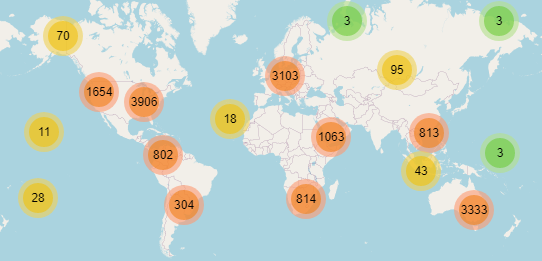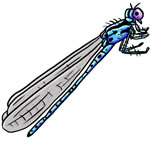What?! You want me to read a fairy story in the middle of all this other stuff? No, it was a sneaky effort to make you look at this case on dragonflies and damselflies. Would you have been more likely to read it if it was entitled Odonata? Now you are here, read on about these insects and the services they carry out for humans.
Page Contents
Background

Dragonflies and damselflies are two groups of carnivorous flying insects which are collectively known as the Odonata.
Dragonflies and damselflies are often regarded as among the most glittering jewels of the entomological world, due to their bright metallic colours and their magnificent flying abilities (at up to 35km per hour). Odonates have been on earth in various forms for the last 250 million years, maintaining the same basic body plan which has been super successful.
Dragonfly/Damselfly differences
The two groups are superficially similar but there a few telltale differences to look for if you want to distinguish between them.
Global distribution of known species of Odonata
There are about 6,300 different species of dragonflies and damselflies, occurring on every continent except Antarctica. They have been well studied in some countries, but overall, at least a quarter of the Odonata were classified as data deficient in a recent IUCN survey i.e. too little known about them to determine whether they are threatened with extinction or not.

Lifecycle of Odonata

The life cycle of dragonflies and damselflies has three phases
egg - laid in freshwater, hatches into
larva (also referred to as a nymph or an instar) - lives and grows in freshwater, goes through moults, then develops into
adult which leaves the water and flies around until it mates, reproduces then dies
Services
BioIndicators
Odonata are often good indicators of the health of aquatic habitats, sometimes including water edge areas. It is thought that the diversity of species and species composition is the best indication rather than the presence of particular species. As Odonata are visually prominent when adults are present, they can give a useful first impression of aquatic integrity.
Pest control
Both adult and larval phases of Odonata species are ferocious predators with voracious appetites. Most studies of their predation potential have concentrated on the larval stage. Odonates eat insects, many of which are pests, most notably mosquito larvae (commonly known as wrigglers). Insufficient studies have been conducted to assert without that Odonata species are effective pest controllers, but there is anecdotal evidence that indicates further study would be of interest.
Biomimetics
Just as The Diabolical Ironclad Beetle can teach us about material strengths, the Odonata can teach us about manoeuverability, speed, and visual guidance control in flight. Sophisticated aerodynamic analysis of Odonate flight is assisting humans in understanding the complex field of unsteady aerodynamics. Also studies of the Odonate eye have been useful in the study of managing complex flying patterns. In addition, the structure of the wings has added to our knowledge of possible windmill blade design.
Cultural
Imagery related to Odonata species has been used for centuries especially in Japan. Japanese culture has also produced poetry in the form of haiku featuring dragonflies and damselflies. Imagery has also been an inspiration in contemporary cultural works such jewellery, household goods and in theatrical advertising. As well as being featured in tangible objects, Odonata feature in legends/folklore created by indigenous groups in various parts of the world. e.g. https://worlddragonfly.org/odonates-in-human-culture/
There are organisations and societies around the world devoted to Odonata appreciation e.g. Worldwide Odonata
Summary of services provided for us
- Bioindicator use
- Services for ecosystem stability
- Possible pest control
- Biomimetic information and inspiration
- Cultural and aesthetic enrichment
Threats to the services?
In the first global assessment of dragonflies and their closely related cousins, the damselflies, scientists found that their numbers are in decline worldwide, largely due to the destruction of wetlands. In total, the assessment found that about 16% of 6,000+ species of dragonflies and damselflies, making up the taxonomic order Odonata, are at risk of extinction.1
Note that Odonata are subjected to both aquatic and terrestrial stressors as they occupy both environments across their lifetimes.
Drainage, sedimentation and clearing
The study referred to above found that draining, sedimentation and clearing wetlands is a major reason for this decline.
“By revealing the global loss of dragonflies, today’s Red List update underscores the urgent need to protect the world’s wetlands and the rich tapestry of life they harbour. Globally, these ecosystems are disappearing three times faster than forests,” said Dr Bruno Oberle, IUCN Director General. “Marshes and other wetlands may seem unproductive and inhospitable to humans, but in fact they provide us with essential services. They store carbon, give us clean water and food, protect us from floods, as well as offer habitats for one in ten of the world's known species.”2
Since 1900, 64 percent of the world's wetlands have disappeared, with 35 percent of wetland habitat losses occurring after 1970.3
Chemical pollution
Pollution is also a factor threatening Odonates. Fertiliser run-off, untreated sewage and factory waste discharge all have a negative effect on dragonfly and damselfly populations.
Climate change
As climate change forces restructuring of species distribution, this means the assembly of Odonata may change at locations across the world and it remains to be seen if the new communities formed will be stable in the long term.
What can we do to retain these services?
Join local field naturalist type associations for information and to find like-minded people.
Promote dragonflies and damselflies on public forums such as social media and newspapers.
At both local, state and federal levels, support policies that promote wetlands, streams and rivers having riparian buffer zones — strips of protected land next to freshwater sources that are off-limits to agriculture and construction.
“To conserve these beautiful insects, it is critical that governments, agriculture and industry consider the protection of wetland ecosystems in development projects, for example by protecting key habitats and dedicating space to urban wetlands.” quote from Dr Viola Clausnitzer, Co-chair of the IUCN SSC Dragonfly Specialist Group.4
Dig deeper
- World Dragonfly Association
- World Odonata List
- New assessment finds dragonflies and damselflies in trouble worldwide
- Setting the scene
- Flight mechanics of a dragonfly
- Simaika, J.P.; Samways, M.J. Valuing dragonflies as service providers. In Dragonflies and Damselflies, Model Organisms for Ecological and Evolutionary Research; Córdoba-Aguilar, A., Ed.; Oxford Univ. Press: Oxford, UK, 2008; pp. 109–124.
- New assessment finds dragonflies and damselflies in trouble worldwide [↩]
- Dragonflies threatened as wetlands around the world disappear - IUCN Red List [↩]
- Global Wetland Outlook [↩]
- Dragonflies threatened as wetlands around the world disappear - IUCN Red List [↩]























